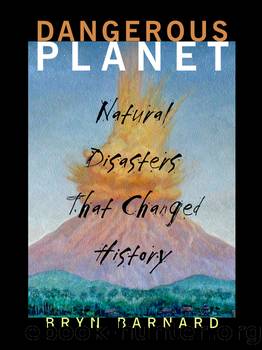Dangerous Planet by Bryn Barnard

Author:Bryn Barnard [Barnard, Bryn]
Language: eng
Format: epub
ISBN: 978-0-449-81493-2
Publisher: Random House Children's Books
Published: 2012-11-28T00:00:00+00:00
Seventeenth-century London was still a medieval city. Buildings were closely packed, half-timbered, and pitch-roofed, easy prey to fire. When the spark came from the bakery on Pudding Lane, the flames quickly spread, pushed by an east wind.
You must try the rat flambé
The fire spread from Pudding Lane down Fish Street Hill to the warehouses and wharves of Thames Street. There the flames fed on the stores of hay, timber, coal, tallow, brandy, oil, and hemp. Engorged with these combustibles, the fire became too fierce for the primary defense of the day: bucket brigades. These volunteers tried to put out fires by dousing them with pail after pail of water, passed hand to hand from a water source to the blaze. In this case, the water was supposed to come from the Thames River. That supply was cut off when the fire burned the waterwheel at London Bridge, the only reliable way to move large quantities of water from the river to street level.
Fanned by an east wind, the fire spread into the heart of the city, threatening the wealthy area of Cornhill. The indecisive Lord Mayor Bludworth hesitated to authorize the next preventative measure, depriving the fire of fuel by demolishing the fashionable homes now in its path. So the flames continued to spread, engulfing the famous St. Paulâs Cathedral. The heat caused the lead seams of the churchâs roof to run in streams and the stones of the walls to explode like grenades. Refugees streamed from the city, carrying what they could into the Thames and out of the city to the surrounding countryside.
Eventually King Charles himself ordered firebreaks. Buildings were pulled down with poles, ladders, and axes or blown up with gunpowder. Finally, on the fourth day of the blaze, the wind died and the fire was contained. Four-fifths of the city had been destroyed, an area of about one and a half square miles. Gone were 13,200 homes, 44 guild halls, and 84 parish churches, a degree of devastation not seen again in London until the Blitz of World War II. Some 100,000 people were made homeless. Astonishingly, by official counts, only four people died.
Yet there was some benefit. The Great Fire ended an epidemic of bubonic plague that had begun the previous year and killed 68,000 people. The flames had incinerated the cityâs plentiful rat population, whose fleas had been the primary carriers of the plague.
Download
This site does not store any files on its server. We only index and link to content provided by other sites. Please contact the content providers to delete copyright contents if any and email us, we'll remove relevant links or contents immediately.
Man-made Catastrophes and Risk Information Concealment by Dmitry Chernov & Didier Sornette(5650)
The Revenge of Geography: What the Map Tells Us About Coming Conflicts and the Battle Against Fate by Kaplan Robert D(3961)
Zero Waste Home by Bea Johnson(3655)
In a Sunburned Country by Bill Bryson(3368)
COSMOS by Carl Sagan(3348)
Good by S. Walden(3347)
The Fate of Rome: Climate, Disease, and the End of an Empire (The Princeton History of the Ancient World) by Kyle Harper(2874)
Camino Island by John Grisham(2719)
A Wilder Time by William E. Glassley(2690)
Organic Mushroom Farming and Mycoremediation by Tradd Cotter(2567)
The Ogre by Doug Scott(2501)
Human Dynamics Research in Smart and Connected Communities by Shih-Lung Shaw & Daniel Sui(2431)
Energy Myths and Realities by Vaclav Smil(2380)
The Traveler's Gift by Andy Andrews(2299)
9781803241661-PYTHON FOR ARCGIS PRO by Unknown(2269)
Inside the Middle East by Avi Melamed(2230)
Birds of New Guinea by Pratt Thane K.; Beehler Bruce M.; Anderton John C(2175)
A History of Warfare by John Keegan(2105)
Ultimate Navigation Manual by Lyle Brotherton(2048)
